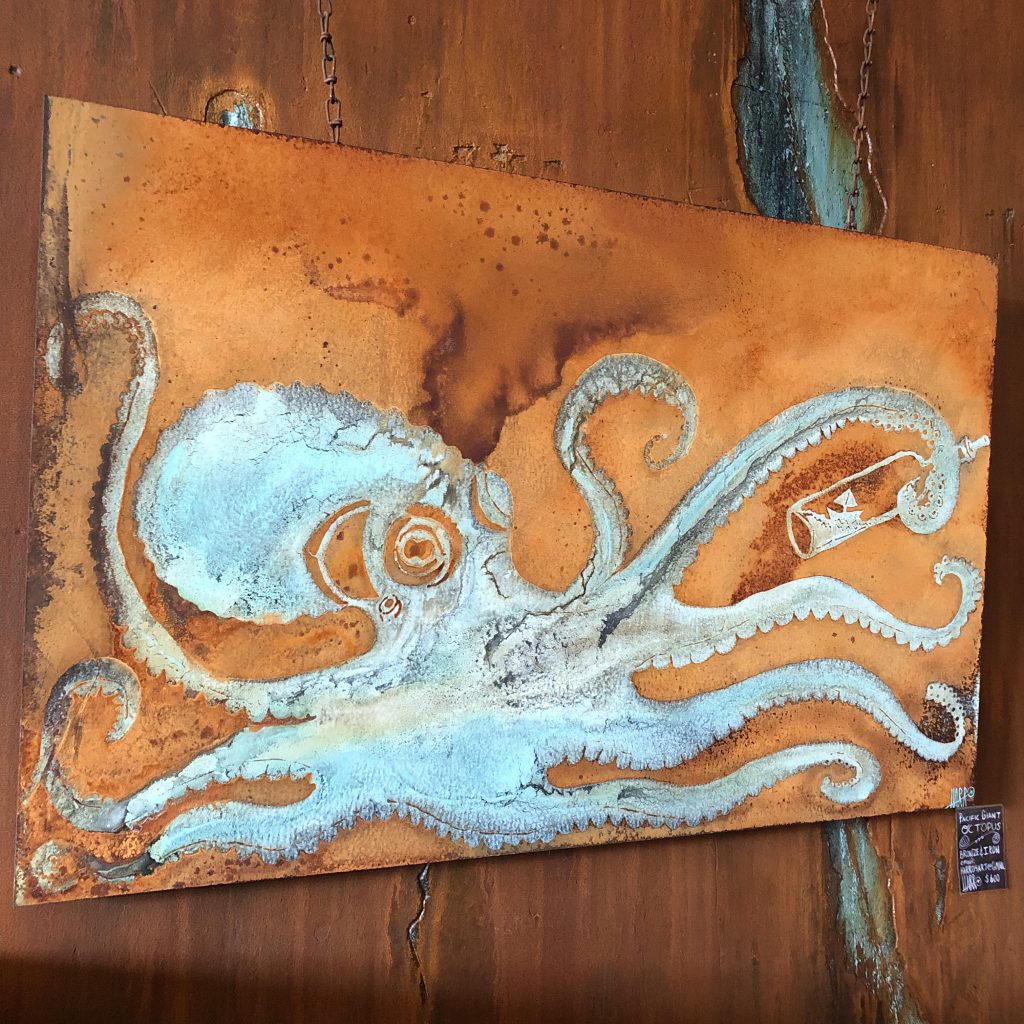By Alec Clayton
Harro, who goes by the one name only — like Prince or Pink or Adele — is an Olympia artist. In his own words, he says, “Harro grew up street smart dodging ferry traffic on the salty shores of Mukilteo, in Snohomish County. His love for the unique Puget Sound environment is evident in his work. Where towering steel buildings meet waterfront ecosystems that are home to Urban Salmon that swim amongst us. Working with metals and patinas, his art is nature’s alchemy.”
Harro’s art evidences a deep concern for Puget Sound’s delicate and threatened ecology, and an understanding of and appreciation for the effects of time and weather on both natural and human-made materials. He creates wall-hung images of salmon, octopi and jellyfish, using materials that change color and patina due to effects of moisture and ravages of time, though they are impervious to weather once a final overlay is added.
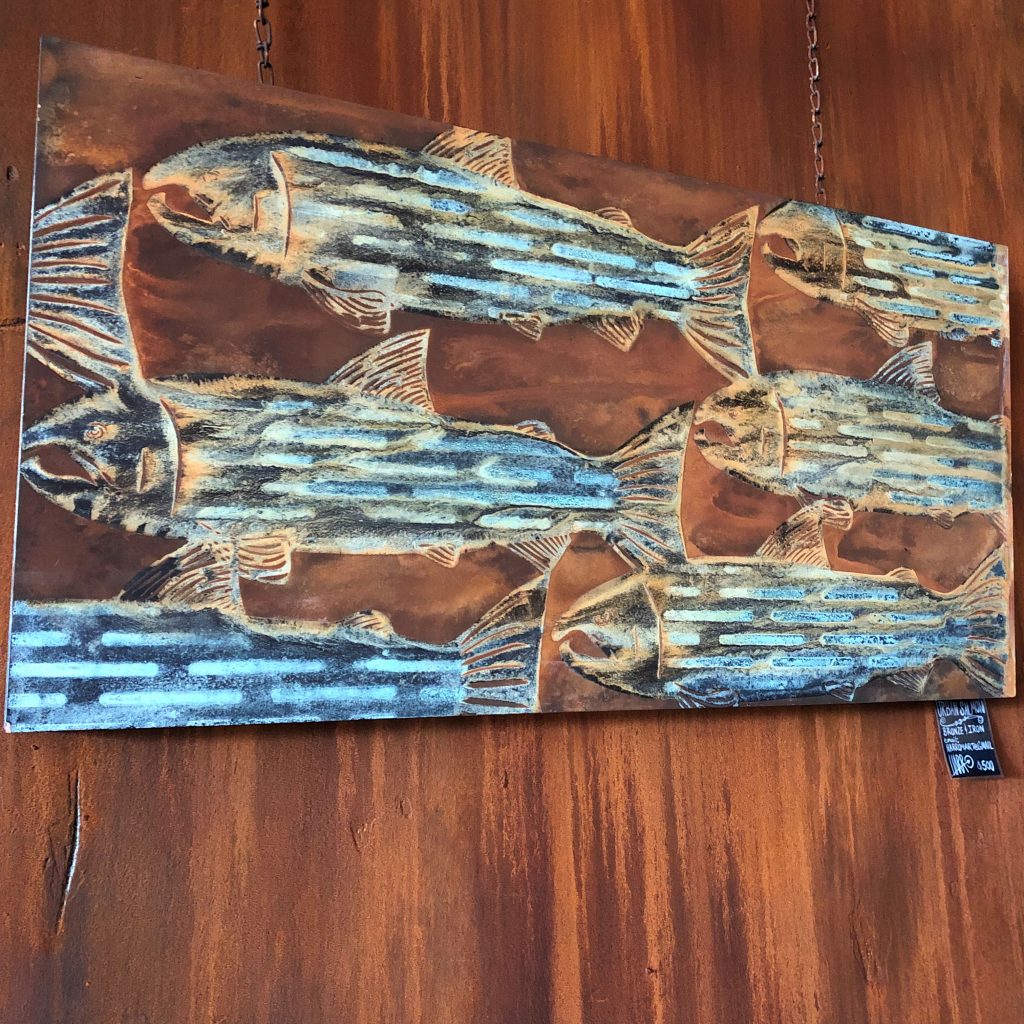
There is a panel picturing multiple salmon in tones of light blue, brown and gray swimming upstream on a rusted metal slab hung by a chain. There is a decorative octopus in shades of orange and rust on a gray background that looks like an elaborately patterned hot air balloon rising to the heavens, with a line of pine trees in front of stylized waves encircling balloon/octopus. There is a blue killer whale diving into the deep, with streaks of darker blue like rivers and webs of something like hair or filament running through it. And a majestic blue heron standing proudly.
Some of Harro’s pieces are on gallery-wrapped canvas. Most are on MDO wood panels, with a smooth surface that he builds with marine grade wood, stainless hardware with a weather-resistant resin overlay bonded to the wood by heat and pressure and waterproof glue.
“My process is somewhat proprietary,” Harro states. “I started out using sheet metal for stencil material. I would hand-draw, hand-cut 16-gage steel using a plasma cutter. I had to use such stout material because the high pressure that was needed to atomize ground-up iron was so destructive. I’ve since found that I can get the same result using car magnet sheets used to print business names on vehicles. It’s easier to cut the magnet sheet with a razor knife than cutting the sheet metal with the plasma cutter.” He uses a reactive architectural coating that is used for exterior structures.
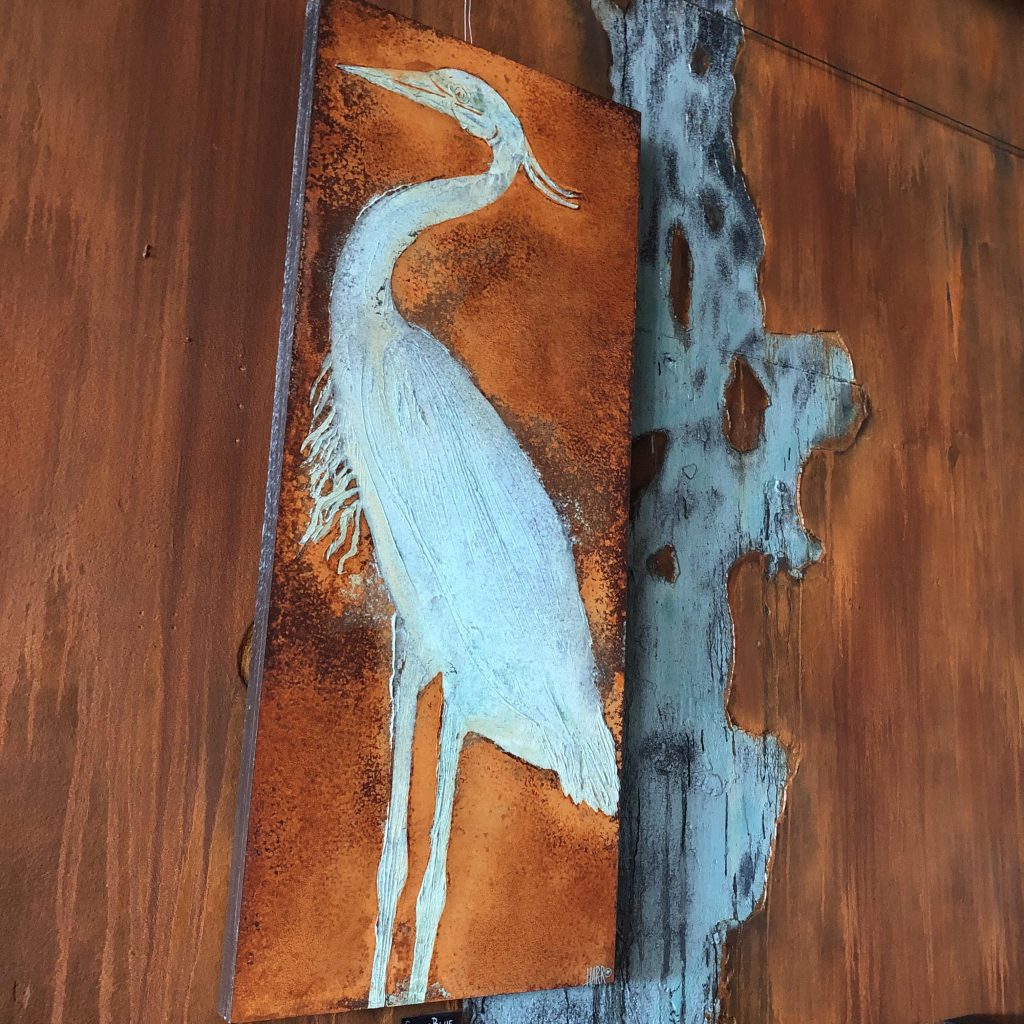
The patina process, Harro says, turns reactive metals from bright copper to a turquoise green, applying ages in under an hour. “When I make art out of this product and tag the manufacturer in my social media posts,” he explains, “they reach out to me and question if I’m really using their product.”
Harro elaborates: “Their marketing and sales department calls me and doesn’t believe that I’m using their product or I’m combining it with another product to manipulate the finish. The technical data and research department of the product manufacturer will reach out to me separately and they do believe that I’m using their product solely. They just want to pick my brain as to how I’m getting the results that I am. All the manufacturer is willing to give me in compensation for my process of 18 years in the making is an Instagram takeover of their account for a week. I still take their calls.”
Harro created the outside face of Octapas Café in downtown Olympia, giving it a patina similar to that of his art, and he rusted and patinated the interior wall of the café in the same manner.
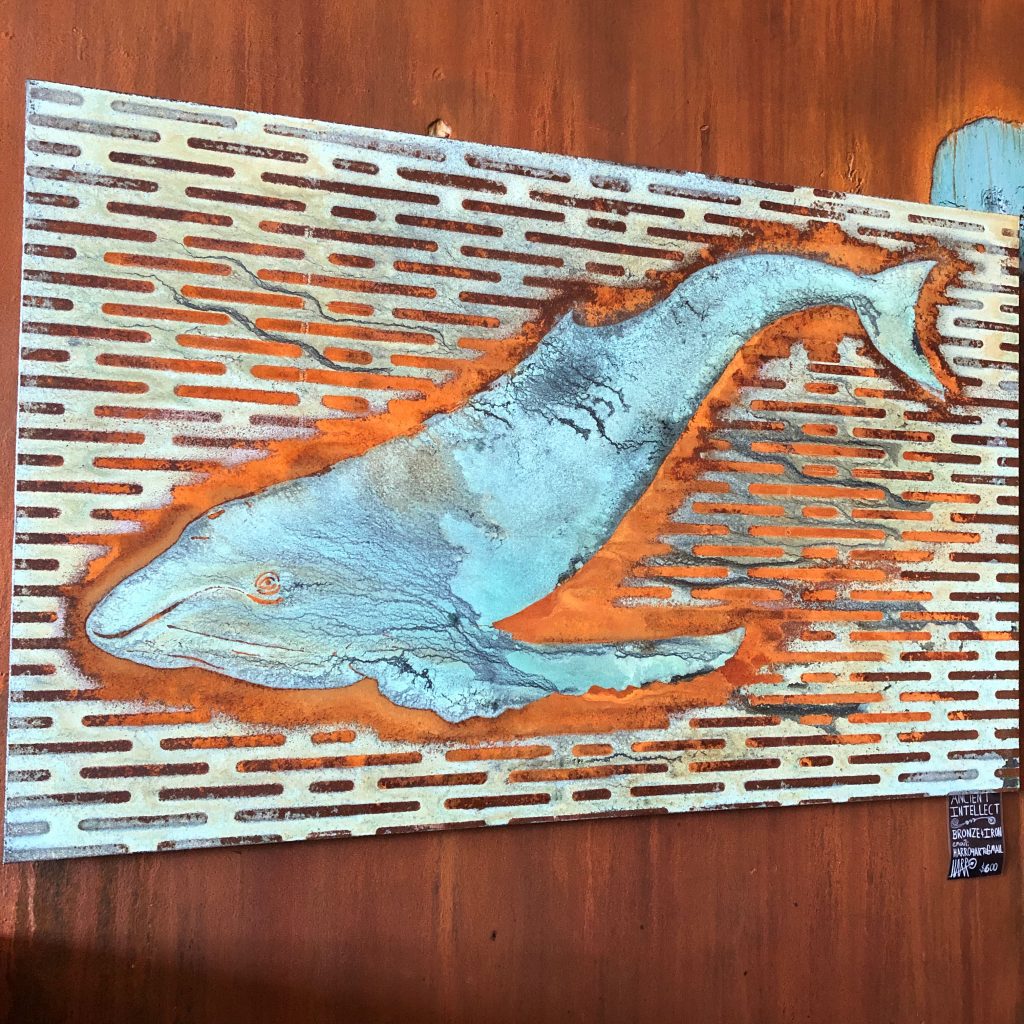
Since Harro’s work is made of marine grade materials and is finished using an architectural coating, it can be safely displayed outside. He says he enjoys viewing his art the most when it’s in an environment that is exposed to the elements. “The bronze that I paint with turns a dark blue with the early morning cold air. As the day warms up, the bronze warms up and goes back to its normal light blue patina. The rust on my paintings is from an iron coating. The rust is real and will continue to develop if the art is exposed to moisture in the air. I put a light clear coat on the art to keep the patina of the bronze and copper from rubbing off with the oils from fingerprints.”
Harro grew up on the shore of Puget Sound. Seeing nature up close when he was young helped shape his vision of the ecosystem and the need to find balance of enjoying but not exploiting nature. “Experiencing nature how it should be, and then seeing nature after humans put their fingerprints on it makes me worry. Being in nature and feeling so connected to the environment feels so natural to me. I think of mankind’s impact on the marine environment under the water that I can’t see. Some Puget Sound salmon swim through polluted cities unnoticed to us. These salmon inspired my Urban Salmon series of paintings.”
Mixing nature with man-made patterns that were salvaged from furnaces, appliances and job-site dumpsters inspires Harro to incorporate patterns from urban garbage into the salmon art. “That pattern applied to the salmon seems so unnatural and makes me think of the effect we are having on the species as a whole. I like my art to speak for all the marine life that lives alongside us and as a reminder for us to be a good neighbor to them. I realize that being a good neighbor requires stepping in to help out when someone or something is in need of help. That act of helping those in need around you helps form a community. That community support that the salmon need is where I put my donations into organizations like The Salmon Center in Belfair. I want to help ensure that salmon will be living amongst us as they have for centuries, for generations to come.”
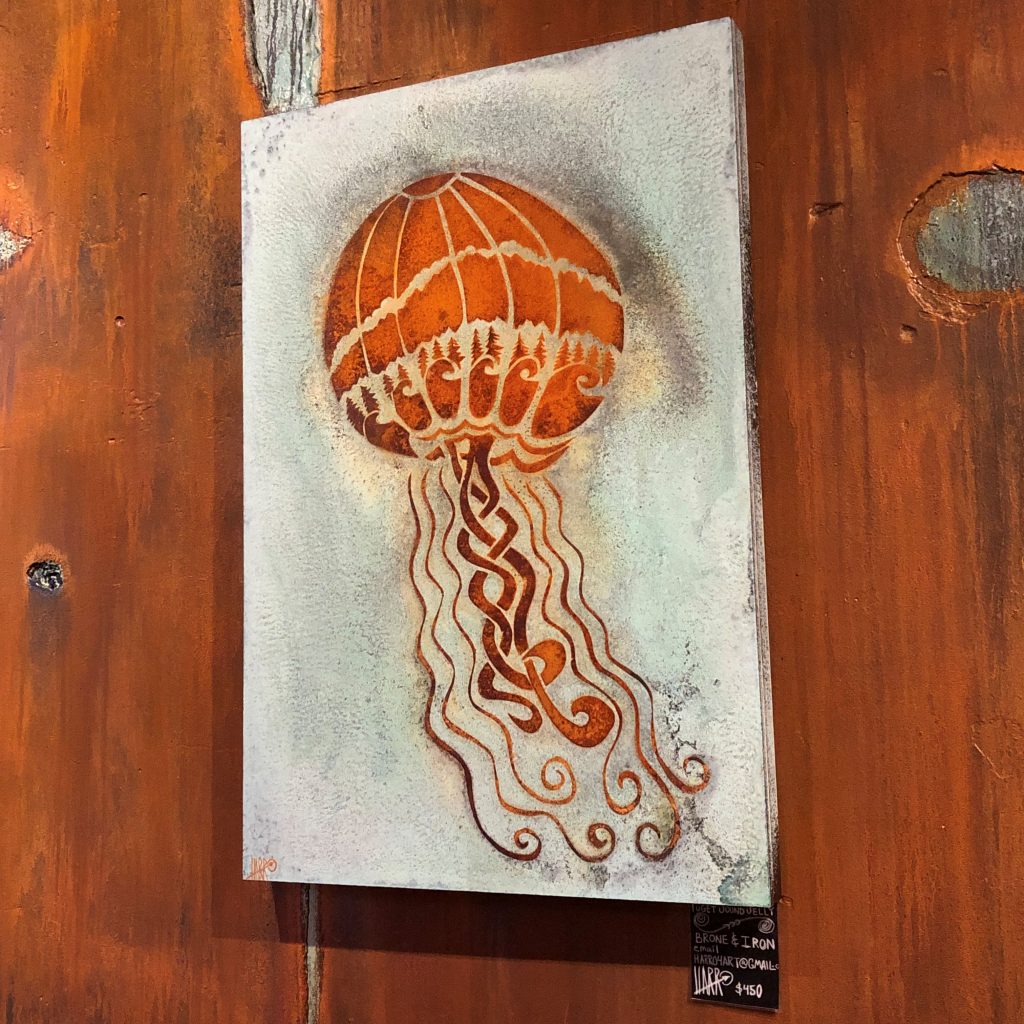
Harro acknowledges that he had great art teachers growing up in Mukilteo. He has been involved in arts programs since elementary school, starting with The Boys & Girls Club. He was one of a handful of students chosen to help an artist paint a mural in his school’s gymnasium. “Those early experiences to public art had me hooked,” he says. “The only formal schooling I had was through the public-school system in Mukilteo. I was lucky enough to have artist Robert H. Stockton as my art teacher for four years of my high school. I owe so much of my understanding of art to Mr. Stockton, forcing me out of my comfort zone to explore new styles. He moved me out of the normal art-class curriculum with my fellow peers to another year advanced. It was like taking college courses in high school.”
Harro was scheduled to show his work at Olympia Arts Walk April 24 and 25, 2020. The event was cancelled in response to the COVID-19 outbreak.

